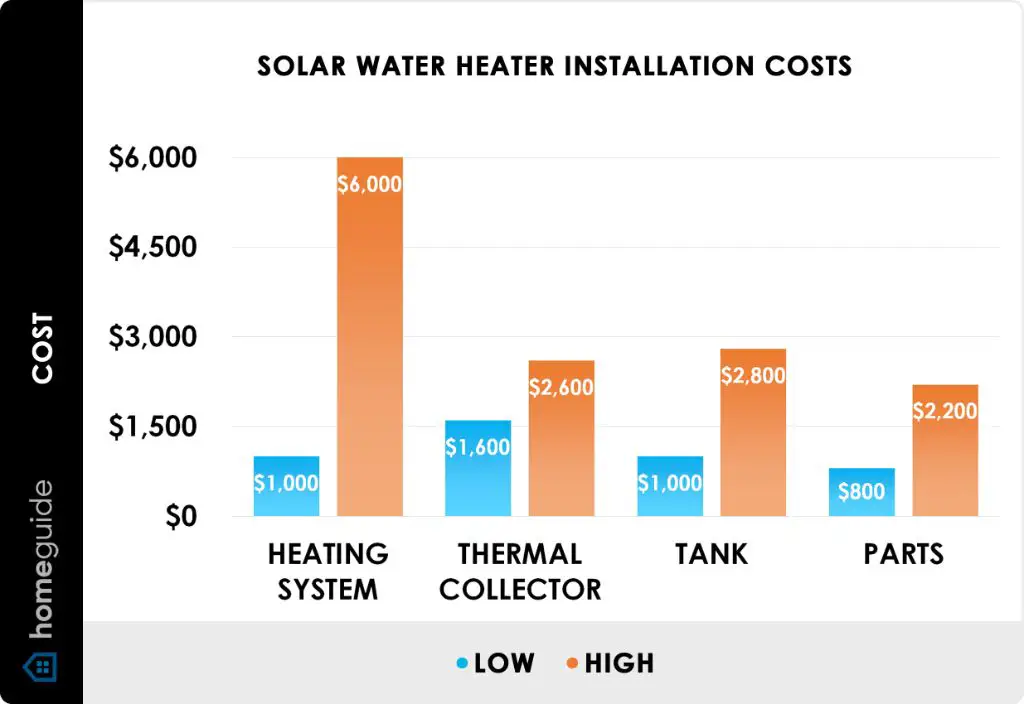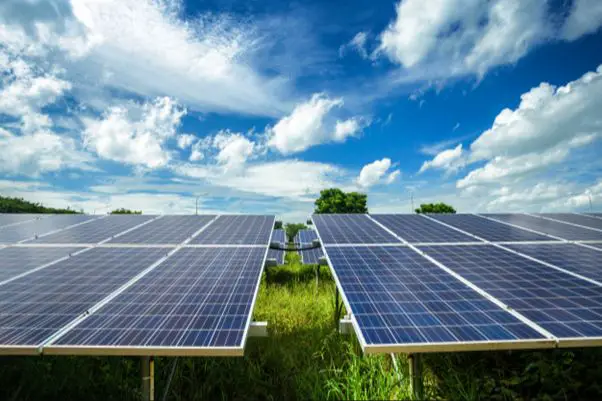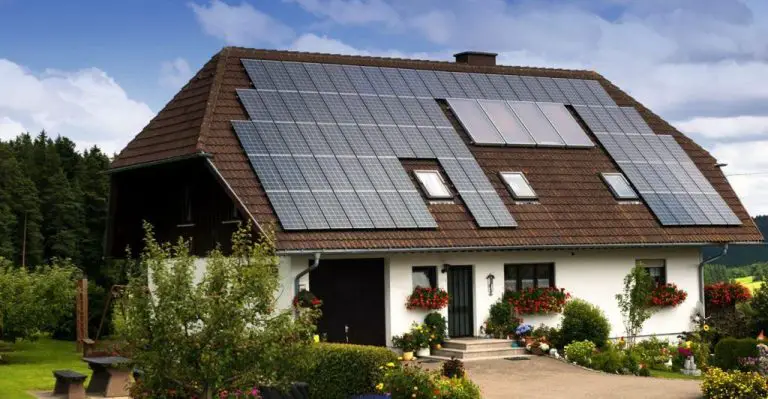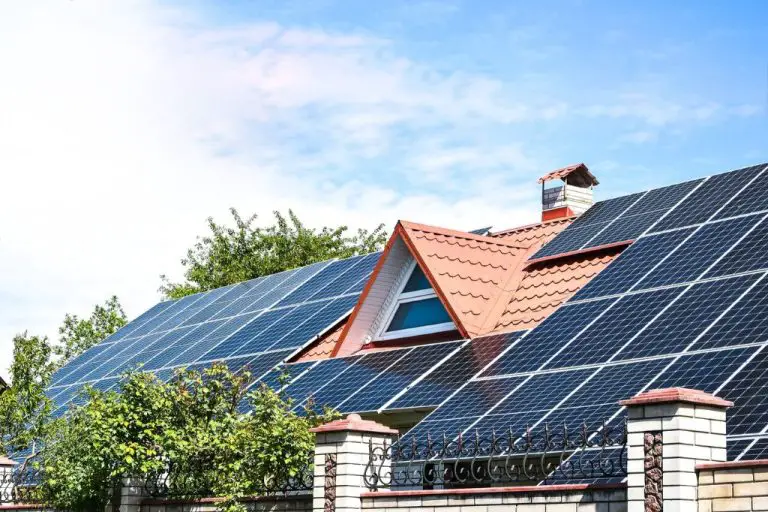How Much Does A Solar Water Heating System Cost?

A solar water heating system uses energy from the sun to heat water for use in homes or businesses. These systems collect solar energy using collectors, usually mounted on the roof, and use it to heat either water or a heat-transfer fluid like glycol. This heated liquid is then kept in an insulated storage tank for use when hot water is needed.
The overall cost of a solar water heating system depends on many factors, including the type and size of system, the local solar resource, installation costs, and available incentives. According to the U.S. Department of Energy, costs for typical household-sized solar water heating systems range from $1,000 to $4,000 for equipment and installation [1]. Larger systems for businesses or pools can cost $5,000 to $20,000 or more.
Key factors that determine the total cost of a solar water heating system include the type of collectors used (flat plate, evacuated tube, etc.), system capacity and design, solar hot water storage tank size, plumbing and installation costs, and location. Upfront costs can be offset by incentives and ongoing savings on water heating bills.
System Components
The main components of a solar water heating system include solar collectors, storage tanks, pumps, controllers and piping (Components of a Solar Hot Water Heating System).
Solar collectors are used to absorb sunlight and convert it into heat energy. Common types of collectors include flat-plate, evacuated tube, and integral collector storage (ICS) (Components).
Storage tanks hold the heated water until it is needed for use. They can be electric, gas, or indirect tank types. Tanks are insulated to minimize standby heat loss.
Pumps circulate water or heat transfer fluid through the collectors and storage tank. They allow the system to transfer heat as needed.
Controllers monitor temperatures and control the pumps to maximize efficiency. They prevent overheating and freezing.
Piping connects all system components. Piping is insulated to minimize heat loss during circulation.
System Types
There are two main types of solar water heating systems: active and passive. Active solar water heating systems have pumps and controls to circulate water or a heat transfer fluid like glycol through the collectors and system. Passive solar water heating systems rely on gravity and the tendency for water to naturally circulate as it is heated.
Active systems are further divided into direct circulation systems and indirect circulation systems. Direct circulation systems pump household water directly through the collectors. Indirect circulation systems pump heat transfer fluid through collectors and use a heat exchanger to transfer the heat to the household water.
Passive systems use a thermosiphon design that relies on warm water rising naturally to the tank above. Another passive design is the integral collector storage system, which combines the solar collectors and storage tank into one unit.
System Sizing
Properly sizing a solar water heating system is crucial to ensure it can meet the hot water needs of a home. The main factors to consider when sizing a system are climate, daily hot water usage, and number of occupants.
In colder climates, a larger system is needed to offset lower solar gains in winter. According to the U.S. Department of Energy, contractors usually follow a guideline of around 20 square feet (2 square meters) of collector area for each of the first two family members, with an additional 8 square feet (.75 square meters) per additional person. So for a 4-person household, the solar collectors should have around 56 square feet (5 square meters) of area (Source).
Daily hot water usage is also critical. The solar storage tank must be large enough to meet demand on overcast days. On average, a solar water heater in a 2-3 person household needs 80-120 gallons of capacity, but large families may need up to 180 gallons (Source). Tracking hot water usage for a week helps properly size the system.
In summary, the sizing of a solar water heating system depends on climate, hot water demand, and family size. Proper sizing ensures the system can provide sufficient hot water year-round.
Installation Costs
The installation costs represent a significant portion of the total cost of a solar water heating system. This includes labor, permits, and any structural modifications needed.
Labor costs will vary greatly depending on your location and the complexity of the installation. Expect to pay anywhere from $500 to $2,000 for professional installation. The more complex the system design and roof work required, the higher the labor costs will be. Hiring a certified solar thermal installer is recommended.
Building permits are typically required and can cost $100 to $500 depending on your municipality. The permit process ensures the system meets local building codes and safety standards.
Structural modifications may be needed to properly mount panels on the roof or accommodate a solar storage tank. This could include reinforcing the roof structure or modifying plumbing to connect the solar storage tank. Small modifications like adding roof mounting hardware are usually minimal. Larger structural changes can add $500 to $2,000+ to the project costs.
To get an accurate estimate for your specific installation costs, get quotes from multiple solar contractors. The site evaluation will determine what customizations are required for your home.
Sources:
https://www.angi.com/articles/how-much-does-solar-water-heater-cost.htm
https://homeguide.com/costs/solar-water-heater-cost
Equipment Costs
The main equipment components that make up a solar water heating system include:
Collectors
Solar collectors are used to absorb the sun’s thermal energy and transfer it to a fluid. There are two main types of solar collectors:
- Flat-plate collectors – These are insulated, weatherproof boxes that contain a dark absorber plate under one or more glass or plastic covers.
- Evacuated tube collectors – These feature parallel rows of transparent glass tubes, each containing an absorber attached to a fin. The air is withdrawn from the space between the tubes to form a vacuum.
According to this source, costs for collectors range from $125 to $800 per 4 square feet.
Storage Tanks
Solar storage tanks hold the hot water until it’s needed for use. They are well-insulated and often have backup electric heating elements. Costs range from $200 to $1,500 depending on tank size and features.
Pumps
Pumps move the heat-transfer fluid between the collectors and the storage tanks. Small electric pumps suitable for residential systems cost $100 to $300.
Other Hardware
Other equipment like controllers, valves, sensors, expansion tanks, and piping add a few hundred to a thousand dollars more to the system cost.
Ongoing Costs
Solar water heating systems require some ongoing maintenance and occasional repairs or replacements to keep operating efficiently. According to the U.S. Department of Energy, the annual maintenance costs for a solar water heating system are estimated to be around $100-$400 depending on the system size and type. This covers inspecting the system, checking connections and pipes, cleaning the collector, replacing glycol fluid, and other routine maintenance tasks.
The major replacement costs come from the pumps, controllers, and storage tanks. Pumps typically need to be replaced every 5-10 years at a cost of $200-$500. Controllers may need replacement every 10-15 years, costing $200-$600 installed. Storage tanks have lifespans around 15-20 years and cost $600-$1,000 to replace. With proper maintenance, the solar collectors themselves can last 20-30 years before needing replacement at a cost of $1,500-$4,000.
Overall, expect to budget around 1-3% of the initial system cost per year for ongoing maintenance, repairs, and periodic replacements of system components over the life of a solar water heater. Proper installation and maintenance is key to minimizing costs and maximizing the return on investment from the system.
Incentives and Rebates
There are various incentives and rebates available to help reduce the cost of installing a solar water heating system. At the federal level, homeowners can claim a tax credit covering 30% of the cost for systems installed through 2032 (Source). The specific requirements to qualify for this credit can be found on the IRS Form 5695. Some state and local governments also offer additional rebates and incentives for solar water heating systems, such as in California and Florida (Source).
Many utility companies offer rebates to customers who install solar water heating systems as part of energy efficiency programs. These rebates can range from $200 to $1000 depending on the utility provider and system size and specs (Source). It’s a good idea to check with your local utility to see what solar hot water rebates may be available in your area.
Taking advantage of the various federal, state, and utility incentives and rebates available can help offset a significant portion of the upfront costs of going solar for water heating.
Return on Investment
The payback period for a solar water heating system depends on the upfront cost of the system, energy costs in your area, available tax credits and incentives, and how much hot water you use. In areas with high electricity rates, payback can occur in as little as 2-5 years. With lower energy costs, payback may take 6-10 years.
According to the U.S. Department of Energy, the average household spends $400-600 per year on water heating. By installing a solar water heater, you can save 50-80% on water heating costs, or $200-500 annually. With a total installed cost of $3,000-6,000 for a solar water heater, the simple payback period would be around 6-10 years.
However, many states and utilities offer rebates and tax credits for solar water heaters that can reduce the payback period. For example, the federal solar tax credit currently offers a 26% credit for systems installed in 2022-2023. Many local and state programs also offer additional incentives. Accounting for these savings could lower the payback period to just 2-5 years.
Over the 20-30 year lifetime of a solar water heater, cumulative savings can add up to $10,000 or more compared to an electric or gas water heater. With rising energy costs, lifetime savings could be even higher in the future. The long-term savings from a solar water heater mean the system can pay for itself relatively quickly while also providing decades of free hot water.
Sources:
https://www.energy.gov/energysaver/estimating-cost-and-energy-efficiency-solar-water-heater
https://www.cnet.com/home/energy-and-utilities/solar-water-heaters-everything-you-need-to-know/
Conclusion
In summary, installing a solar water heating system can save a household between 50-80% on water heating costs compared to conventional water heaters (Source). However, the upfront costs of purchasing and installing a system can be high, ranging from $3,000-$10,000 depending on the type and size of the system.
The pros of solar water heating include significant long-term energy savings, reduced electricity usage, and lower environmental impact. The cons are the high upfront costs and need for proper solar access on your roof or property. Solar water heating systems also require more maintenance than conventional water heaters.
Overall, solar water heaters can be a smart investment for eco-conscious homeowners looking to save money on energy bills in the long run. The payback period can range from 6-12 years. With solar tax credits and utility rebates, the return on investment can be even faster. For those with adequate solar resources and upfront funds, solar water heating is an efficient way to heat water while reducing your carbon footprint (Source).






